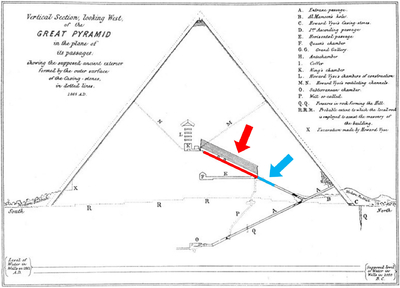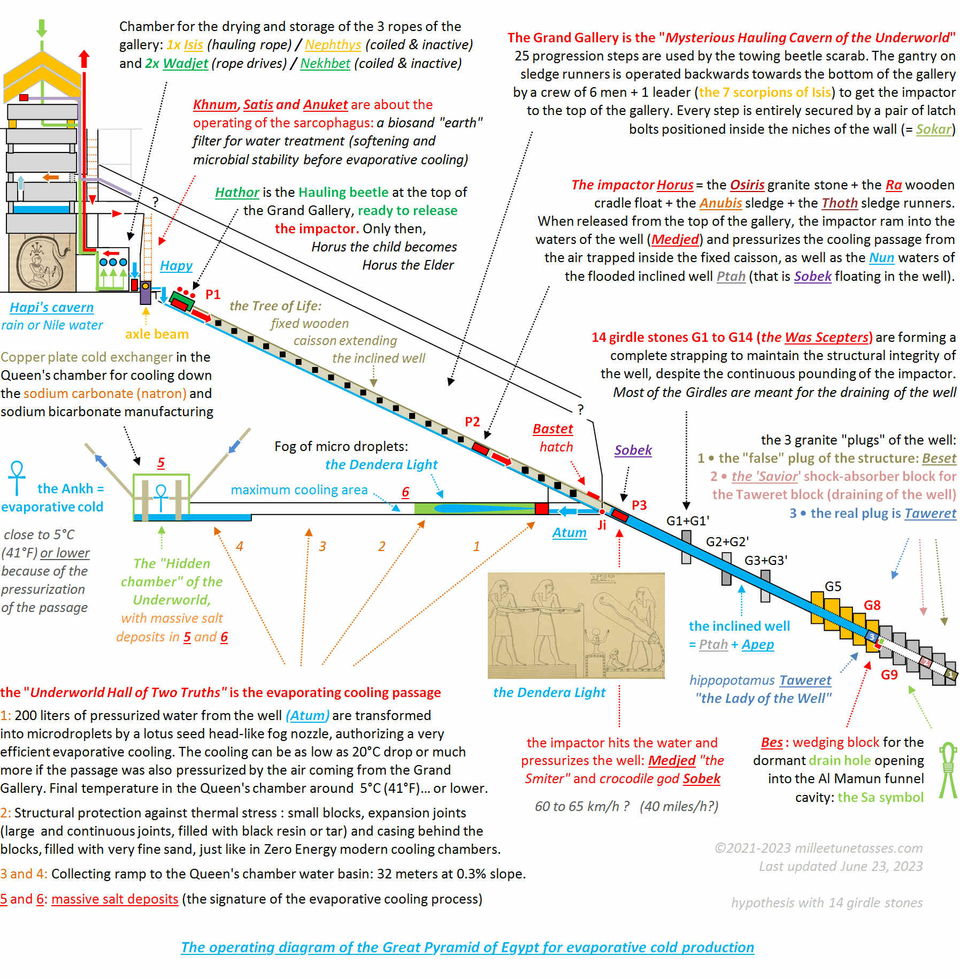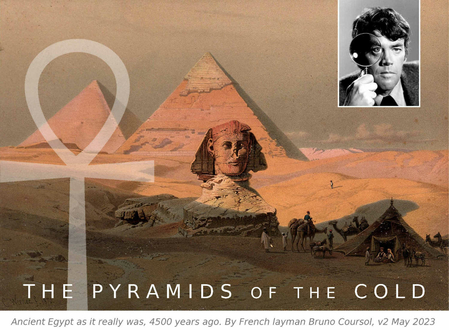- Retour accueil
- Vous êtes ici : Blog The Pyramids of the Cold v2 The Pyramids of the Cold Section 14 • The immersed Osiris stone and the seed metaphor
The Pyramids of the Cold Section 14 • The immersed Osiris stone and the seed metaphor
Publié par Bruno Coursol dans The Pyramids of the Cold v2 le 13/05/2023 à 19:20

Statuette of Osiris at the Metropolitan Museum of Art: metmuseum.org/art/collection/search/545802
The Pyramids of the Cold v2 (May 2023) • Part C: the impactor of the Great Pyramid of Giza
Section 14 • The endlessly immersed into water Osiris stone and the seed metaphor

In summary: if Osiris is the ancient Egyptian god of resurrection, the after-life, fertility and agriculture, it is because he is the deification of the "power source" of the Great Pyramid of Egypt. Because Osiris is the deification of the granite weight of the impactor of the Great Pyramid, the Osiris stone, it is Osiris who gave life to the Pyramid in an endless cycle in which the impactor ended up in the waters of the inclined well between each and every of these cycles.
In other words, Osiris has been endlessly immersed into the waters of the well, and that gave life to the Pyramid.
This endless cycle of getting in and out of the waters of the well is what the germinating beds of Osiris are all about.
It is also possible (and very likely), that this sacred cycle of immersion of the Osiris stone into water, is the origin of the Christian ritual of baptism into the water: even if the ritual can be performed by simply pouring water on the baptized, it is highly recommended to proceed to a full immersion instead.

Osiris has been identified with Fertility and Agriculture, because hidden in his wooden cradle coffin, he would have looked like a seed, just waiting for germination. "Epigeal vs. hypogeal germination", by Kat1992: https://en.wikipedia.org/wiki/Epigeal_germination. Ancient Egyptian god Osiris by Jeff Dahl: https://en.wikipedia.org/wiki/Osiris#/media/File:Standing_Osiris_edit1.svg
14.01 Osiris and the seed metaphor
I first thought that if Osiris was represented with a green color face, it was because the granite stone he was the deification of, was made of green granite. But this is most probably wrong, because Osiris doesn't just have a green color face: he is also the god of fertility and agriculture.
The green color can't be the explanation for this, but if we take a few steps back and try to imagine how ancient Egyptians could have seen Osiris, completely invisible because hidden inside the wooden coffin and constantly thrown and immersed into the waters of the inclined well, it could have been seen like a seed that would have been just planted into the soil and regularly watered.
Just like the seed contains all the force of the future plant, Osiris contains all the power of the impactor.
Hidden in the wooden cradle Ra, Osiris would have been associated with a well watered seed, just planted into the soil, preparing itself for germination, and Osiris would have become the god of fertility and agriculture.

14.02 The impactor of the Great Pyramid of Egypt
The nested position of the granite weight Osiris stone inside the impactor Ra, is what triggered the seed metaphor: the Osiris stone does really look like a seed, planted into the soil... and waiting to be watered, over and over again.
14.03 Osiris "Banebdjedet" merging with Ra and giving him all his force and power
Not only the germinating beds of Osiris is a perfect reinterpretation of the composite original design of the impactor, but the idea itself of Osiris merging with Ra, and giving to him all his force and power is already perfectly known, in one of Osiris' aspect: Banebdjedet (also "Banebdjed").
Ra at this time becomes merged with Osiris, the judge of the dead, and Osiris is seen as the “corpse” and Ra as the “soul” of the single deity Ra-Osiris." https://www.worldhistory.org/Ra_(Egyptian_God)/
"Osiris' soul, or rather his Ba, was occasionally worshipped in its own right, almost as if it were a distinct god […] This aspect of Osiris was referred to as Banebdjedet. […] As Banebdjed, Osiris was given epithets such as Lord of the Sky and Life of the (sun god) Ra. Ba does not mean "soul" in the western sense, and has to do with power, reputation, force of character, especially in the case of a god. […] Since the ba was associated with power, and also happened to be a word for ram in Egyptian, Banebdjed was depicted as a ram, or as Ram-headed." https://en.wikipedia.org/wiki/Osiris ("Ram god" section)

Statuette of Osiris, Late Period ca. 588–526 B.C. at the MET: metmuseum.org/art/collection/search/546747
Figure of Ptah-Sokar-Osiris at the Metropolitan Museum, New-York: metmuseum.org/art/collection/search/551504
Statue of Harbes, called Psamtiknefer, son of Ptahhotep. Harbes was an official of the pharaoh Psamtik II. This statue depicts him protecting a figure of the god Osiris. Harbes wears the king's two cartouches on either shoulder. The statue was anciently set up in Karnak Temple at Thebes, where it constitutes a rare example inscribed for this king. Accession Number: 19.2.2. Late Period, Saite, 595–589 B.C. at the Metropolitan Museum of Art, MET New-York: https://www.metmuseum.org/art/collection/search/546748

Germinating beds of Osiris at the Metropolitan Museum of Art, New-York. "Beginning in Dynasty 18, beds were made on which soil was molded into the shape of the god of regeneration and ruler of the dead, Osiris. Thickly sown with grain and kept moist until the grain sprouted and grew, then left to dry again, these figures were created as part of a ritual carried out in association with the Osirian Festival of Khoiak." https://www.metmuseum.org/art/collection/search/553820
14.04 The reproduction of the impactor's cycle in and out of the well: keeping the grain moist, then left to dry
The germinating wooden beds of Osiris, or bricks of Osiris, are particularly interesting, because not only the shape of Osiris is perfectly respected in order to duplicate the original granite stone perfectly nested into the wooden cradle, but the endless cycle of the impactor inside the inclined well, then outside the well, is also duplicated: first you keep the seeds moist until germination, and then you let the sprouted grain dry.
Osiris-Nepra (E. A Wallis Budge), with wheat growing from his body. From a bas-relief at Philae: https://en.wikipedia.org/wiki/Osiris

A river baptism in North Carolina at the turn of the 20th century. Full-immersion (submersion) baptism continues to be a common practice in many African-American Christian congregations today. https://en.wikipedia.org/wiki/Baptism#/media/File:River_baptism_in_New_Bern.jpg
14.05 The immersion of the Horus impactor (Ra + Osiris) in the waters of the well and the possible link with the Christian Trinity and Baptism immersion into water
I'm sure many will find very close similarities between what was realized inside the Grand Gallery, and some religious beliefs, like resurrection of the Christ and the Baptism ritual.
Because, one way of summarizing what we know of the operating of the impactor of the Great Pyramid, in just a few words, is that the three gods who were the glorification of the impactor: Ra, Osiris and Horus, were all together, the three of them constantly immersed into the waters of the well; and every time they would rise again from these waters and reborn again, until the next cycle begins.
These three ancient Egyptian gods, immersing themselves before being reborn, sounds very similar with the Christian Baptism ritual and the doctrine of the Trinity: "the three consubstantial gods".
"Baptism […] is a form of ritual purification—a characteristic of many religions throughout time and geography. In Christianity, it is a Christian sacrament of admission and adoption, almost invariably with the use of water. It may be performed by sprinkling or pouring water on the head, or by immersing in water either partially or completely, traditionally three times, once for each person of the Trinity." https://en.wikipedia.org/wiki/Baptism
"The Christian doctrine of the Trinity […] defines one God existing in three coequal, coeternal, consubstantial divine persons…" https://en.wikipedia.org/wiki/Trinity

Relief in the tomb of Paschedu, Deir el-Medina, Egypt, Luxor West-Bank, photographed by kairoinfo4u: https://www.flickr.com/photos/manna4u/430887106/in/album-72157600016963557/
14.06 Osiris represented really moving towards water in the tomb of Paschedu
This relief is just like every single piece of the ancient Egyptian religious art: a pure glorification of what happened in the Great Pyramid. Here, Osiris is depicted descending the "hill" of the Grand Gallery towards the waters of the inclined well. The flail he is holding being the representation of the water plumes forming behind his path.

Api or Hapi (Apis, Taureau Consacré a la Lune)", 1823-25, by the French illustrator Léon-Jean-Joseph Dubois, at the Brooklyn Museum: https://www.brooklynmuseum.org/opencollection/archives/image/55326
14.07 The cooling of the limestone kilns and the flails pointing backwards and downwards
Amazingly, these two above images are about the same thing: the water that is pushed ahead of the impactor and backwards in gigantic plumes. Even if the vast majority of the flail representations are very stylized, there are some "street-artist" versions in the open desert, and they are crystal clear: flails are about using water.
We've seen that the Apis bull (just like Horus) is the deification of the impactor, projecting waves of water in front of him and gigantic plumes of water backwards, because the impactor is moving into the fixed caisson where water is running into it (probably constantly).
As the glorification of the granite stone from which the impactor gained all his power and all his ramming force, Osiris is represented here doing the exact same thing. The flail pointing backwards and downwards is easy to understand, but the frontwards wave isn't.
The context here is the cooling of the kilns; there is no frontwards wave represented, but it is here, cooling down the kilns on the right.
14.08 The fundamental difference between Osiris, Horus and the Apis bull
We'll see in the next paragraphs, that Osiris, Horus and the Apis bull (as well as every single over bull deity, prior to the impactor of the Great Pyramid) are metaphoric representations of the exact same thing: the impactor of the Great Pyramid. When Horus and Osiris are about the speed of the impactor and the speed of the Osiris stone (respectively), the Apis bull is about the ramming power of the impactor.
We'll also see that Medjed "the Smiter" is him about the "invisible" side of the ramming impactor, hidden inside the central wooden caisson.

14.09 When Osiris and Horus are directly associated with "cooling" and "cold water"
"Osiris N, take this fresh water, cooled for you by Horus, in your name of He-who-is-come-from-the-fresh-water". […] "The most complete ancient work in existence of the myth of Osiris which we know is that of Plutarch, in his 'De Iside et Osiride'. We know the stratagem used by Seth and his associates, and we know how the conspirator, having locked Osiris precisely by guile in a chest made to his measurements, threw it into the sea, an episode which Plutarch is the only one to relate, began the mourning and the quest of Isis. […] Osiris is designated as the one who had been "put in a chest (deben), in a box and in a bag".Nadine GUILHOU: Les deux morts d'Osiris, d'après les textes des Pyramides.
Extracted from the magazine "Egypte", N°10, August 1998: https://www.osirisnet.net/dieux/osiris/e_osiris_03.htm
"But I am parched with thirst and I perish. Give me quickly the cold water flowing forth from the Lake of Memory". Delia, D. (1992). The Refreshing Water of Osiris, page 189. Journal of the American Research Center in Egypt, 29, 181–190. https://doi.org/10.2307/40000492

Diagram of the operating Great Pyramid of Egypt for evaporative cold production (hypothetically for chemical manufacturing cooling of pure sodium carbonate "natron", the salt used for the mummification of pharaohs). When in operation, the elevation of the Great Pyramid was not finished, and it is only after the shutdown procedure and the draining of the inclined well, that the 3 granite plugs were finally close to one another.

The Pyramids of the Cold version 2 (May 2023 - April 2024)
Summary of the study and Table of Contents
Part A: The evaporative cooling process
Section 1 • The horizontal evaporative cooling passage layout
Section 2 • The Dendera Light and the creation of the fog of microdroplets by the fog nozzle
Section 3 • The water cycle glorifying metaphors: Geb, Shu, Nut, Tefnut
Section 4 • The theorization of the evaporative cooling process by Akhenaten and Nefertiti
Section 5 • The theorization of the evaporative cooling process in the Weighing of the Heart
Part B • The inclined well of the Great Pyramid of Giza
Section 6 • The inclined well layout and the girdle stones
Section 7 • The Taweret "Lady of the Well" temporary sealing granite plug of the well
Section 8 • The Bes temporary wedging block immobilizing Taweret
Section 9 • The draining of the well
Section 10 • The Great Serpent Apep and the snake water metaphors
Section 11 • The Was scepter and the control over "snakes"
Section 12 • The beating Heart of the Great Pyramid
Part C • The composite impactor of the Great Pyramid (Horus, Ra, Osiris, Medjed, Sobek...)
Section 13 • The wooden and stone composite design of the impactor: Ra and Osiris
Section 14 • The endlessly immersed Osiris stone and the seed metaphor
Section 15 • The Anubis sledge and the bobsled mask
Section 16 • The sledge runners of the impactor: Thoth
Section 17 • Medjed: the smiter nobody can ever see
Section 18 • The Apis bull and the ramming impactor's metaphors
Section 19 • The crocodile god Sobek impactor (more or less) floating in the waters of the well
Section 20 • The Obelisk and the Benben stone rising from water
Part D • The Grand Gallery's of the Great Pyramid of Giza
Section 21 • The Sacred "sloping paths" of the "oval-shaped cavern of the act of Hauling"
Section 22 • The central wooden caisson of the Gallery: Sekhmet and the Triad of Memphis
Section 23 • The hauling ropes of the Grand Gallery: Isis, Nephthys, Hatmehit, Wadjet and Nekhbet
Section 24 • The hauling Beetle and the Seven Scorpions of Isis
Section 25 • The Great Cow goddess Hathor and the operating cycle of the hauling Beetle
Section 26 • The 10 operating phases of the Grand Gallery
Section 27 • The guide to the Afterlife for the smart traveler and the canopic jars
Section 28 • The scarab amulet glorifications of the hauling Beetle
Part E • The very large and roughly finished sarcophagus of the Great Pyramid
Section 29 • The biosand filter sarcophagus of the Great Pyramid
Section 30 • The Elephantine Triad deification of the biosand filter of the Great Pyramid
Section 31 • The Great Pyramid's operating flat roof and the water supply issue
Part F • Chemical manufacturing and industrial cooling before the Great Pyramid
Section 32 • The Serdab and the "Refreshment of the Gods" Step Pyramid of Djoser
Section 33 • Sneferu's Red Pyramid and the accumulated ammonia
Section 34 • The Disc of Sabu and the Solvay process for pure natron manufacturing
Part G • The tremendous impact of the Great Pyramid on the whole ancient world
Section 35 • The hidden secrets of the Hermetica Emerald Tablet (around 1600 C.E.)
Section 36 • Thor and the magical Hammer in the Great Hall of Bilskirnir
Section 37 • The Churning of the waters of the Ocean of Milk (Hindu mythology)
Section 38 • The Tibetan prayer wheels and the Grand Gallery's operation
Section 39 and Conclusion • The cooling water of spitting Kebechet
Part H • Epilogue
Section 40 • The smiting Ark of the Covenant and the Ten Commandments
Section 41 • The 293 kilograms windlass Staff of Moses and Aaron... and the First Plague of Egypt: water turning into blood
Section 42 • Ezekiel's Four Egyptian pulley "Wheels within the Wheels" and the four angel ropes
Section 43 • David, Saul, two giant Goliaths, five little stones, an aeolian harp... and a weaver's beam
Section 44 • The holy water fonts and the biosand filter
Part I • The magicians of the Great Pyramid of Giza
Section 45 • The Legend of Khufu and the "magician" polymath Imhotep
Section 46 • The two magical eyes of Isis and the brilliant but painful flame of her twin sister's braids
Section 47 • The Aegis Shield of Athena "Subduer of the Winds" and the upper hatch of the central wooden caisson
Poster un commentaire
